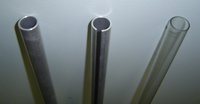Abstract

A magnetic and non-magnetic pellet fall at the same rate in a plastic tube but not in an aluminium tube. What will happen with the slotted tube?
Portable
Yes
Principles Illustrated
Eddy currents, conducting and non-conducting materials, interaction between eddy currents and magnets.
Videos
Aluminium tube without a slot. Download (right-click and “save link as”, 1 MB): Aluminium.m4v
Plastic tube. Download (right-click and “save link as”, 600 KB): Plastic.m4v
Slotted Aluminium tube. Download (right-click and “save link as”, 800 KB):Â Slottedaluminium.m4v
NCEA & Science Curriculum
PHYS 3.6
Instructions
Drop the unmagnetised slug through the aluminium tube. It falls with acceleration g (more or less). Drop the magnetised slug, identical in appearance, through the aluminium tube. Students are surprised to see that it falls much less rapidly. Repeat with the plastic tube and see no difference between the slugs. With the slotted aluminium tube the difference is apparent but not as large as with the unslotted aluminium tube.
Safety
This demonstration works best with a rare-Earth magnet. These strong magnets are very toxic and can be swallowed by children. Be sure to keep careful track of your magnet.
Individual teachers are responsible for safety in their own classes. Even familiar demonstrations should be practised and safety-checked by individual teachers before they are used in a classroom.
Related Resources
Eddy Current Vanes, Eddy Current Drag, Eddy Current Tank, Eddy Current Tubes (multimedia resource).
Teaching Resources
Suggestion: Start with the non-magnetic plug and drop it through the solid Al tube. It will fall as if out in the open. Then drop the magnet through the tube. It falls slowly. Explain the principle of eddy currents: the falling magnet causes currents to flow in the tube. These currents act as an electromagnet. The magnetic plug and the electromagnet interact, with forces opposing the relative motion of the two. This causes the drag.
Next move on to the plastic tube. There is no effect because there are no currents in the plastic.
Ask students to predict what will happen with the slotted tube. Will it work like the solid aluminium tube or like the plastic? Watch the videos to find out. Hint: the eddy currents flow around the solid aluminium tube, but the slot breaks the current path. Compare this with the slotted vanes in the eddy current vanes experiment.
Would you like to contribute lesson suggestions? Contact us.
References
PIRA 5K20.25
Credits
This teaching resource was developed with support from
The MacDiarmid Institute
Faculty of Science, Victoria University of Wellington
School of Chemical and Physical Sciences, Victoria University of Wellington